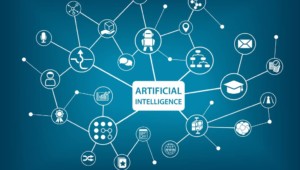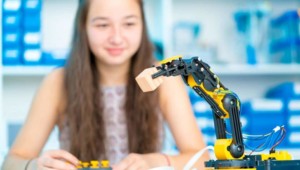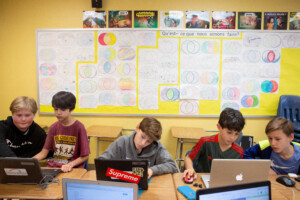Customizable AI-Powered Textbooks Reshape Learning
Key Points
-
The Korean initiative demonstrates the potential of AI in creating personalized learning environments, enhancing student engagement and empowerment.
-
The shift toward AI-powered textbooks in Korea and similar efforts in the U.S. highlights a significant trend in education technology, focusing on real-time data use to tailor learning experiences.

For the last 20 months, generative AI has forced a redo of how educators approach curriculum design, assessment, and instructional support. Textbooks, your time has come.
Beginning this spring, the world’s first large-scale AI-powered textbook implementation will take place in Korean third-, fourth-, and seventh-grade grade classrooms. It is the latest technology-infused attempt to keep the $10-billion textbook industry relevant. This is perhaps the last stage in a long journey.
In 1993, my first year as a sixth-grade social studies teacher, both I and my students were dazzled by Encarta, an interactive encyclopedia CD-ROM that offered a wealth of information, including multimedia content and search capabilities.
A few years later I gaped when I received my Holt textbook (Holt Social Studies: World History). The accompanying CD-ROM included interactive activities, multimedia content, and additional resources to enhance the learning experience. I painstakingly attached a Macintosh Quadra computer to a large-screen (36 inches – can you believe it?) classroom TV, inserted the disc, and pressed play.
Infrastructure development – the e-rate for high-speed wifi as well as mass-produced devices – pushed the next wave of innovation: ebooks. One of the first examples in my subject area was My World 6 from Scholastic in 2004. This digital/etextbook featured multimedia content, including videos, maps, and interactive timelines via a web interface.
The newest development in textbook evolution arrived this year. For the first time, because of Large Language Models such as ChatGPT, Claude, CoPilot, and Gemini, the new etextbooks are customizable down to a granular level. What is the grain size? Individual students.
The Korean Experiment
To find out more about the Korean initiative I contacted the office of Education Minister Lee Ju-Ho. We crossed paths multiple times when he was an economics professor at the Korea Development Institute, where I consulted for years on a project-based learning professional development program.
Mr. Lee’s staff responded to my long list of questions with PowerPoints and detailed PDFs, which form the basis for the analysis that follows.
The goal of the Korean initiative fits on one PowerPoint slide: ”By creating an individualized and tailored learning environment, we seek to empower all students to take the lead in their own growth. Our goal is to nurture every student into a talented individual through personalized education.”
According to the Ministry, the benefit for the students comes down to the effective use of real-time data to deliver personalized instruction tailored to both needs and interests. The benefits to the teacher accrue from that data as well, empowering the teacher (via an AI “teaching assistant) to diagnose learning paths, deliver content recommendations, and provide personalized learning support (see accompanying screenshots of the data dashboard draft version).


While the AI textbooks will include formative assessments built on comprehension questions, that data will not be used to generate grades. Instead, the assessments will be used to diagnose students’ learning characteristics and generate AI-powered support.
The rollout will occur over a multi-year period, launching first with etextbooks in math, English, information, and communication technology, as well as Korean for Special Education Students. Between 2026-2028, additional subjects (Korean, Social Studies, Science, History, Technology/ Homemaking) and grade levels will be added to the system.
The Ministry realizes that the technical rollout needs to be accompanied by a massive professional development program. The training covers the process and methods of understanding the functions of AI digital textbooks and utilizing them for innovation in the classroom. About 10,000 teacher leaders completed the training from May to August this year. Another 150,000 teachers will be trained onsite in the second half of the year.
As you can imagine, Korean parents have reacted with trepidation to the launch of such a comprehensive change to the nation’s education system. The primary fear in dozens of news articles has focused on the additional screen time. The Ministry has a ready response: “Issues such as excessive device use may stem from students not being adequately taught proper device usage. To address this, we plan to strengthen digital citizenship education, ensuring that students use digital technology safely, responsibly, and productively, thereby enhancing their own competitiveness.”
U.S. Initiatives
While the scope and ambition of the Korean AI-powered textbook initiative dwarfs anything being implemented in the U.S. or Europe, there is movement in that direction in the States.
Google, via simple prompts to Gemini, allows college students to access the library of free textbooks offered by OpenStax, Rice University’s 12-year-old educational technology initiative. The organization published its first textbook in 2012 and now offers textbooks in anthropology, English composition, finance, political science, computer applications, contemporary math, and world history.
Pearson, one of the largest educational publishers in the world, began phasing out hard-copy textbooks in 2019 to focus on digital textbooks.
Pearson recently launched three-gen AI tools, including two that will be embedded in digital textbooks. Students using Pearson AI textbooks can highlight challenging sections and receive tailored, simplified explanations from the AI tool. Additionally, the AI can generate quizzes, flashcards, and questions based on the highlighted content.
Beyond the AI features in the textbooks, Pearson has introduced AI chatbots designed to give students immediate feedback as they work on assignments. If a student answers incorrectly, the chatbot can explain the mistake and suggest how to correct it.
U.S.-based McGraw Hill announced in July that it’s launching two AI tools for students, including one that will be incorporated into a number of ebooks. McGraw Hill’s eBook platform features AI Reader, which allows students to highlight text and request alternative explanations or simpler language. AI Reader is intended to create flexible, open-ended learning experiences that develop deep understanding.
Outlook
I like textbooks. I was, as you can surmise, one of the weird kids in school – a profound underachiever who scored in the 99th percentile on state and national assessments. That success was mostly because I was born with a “Jeopardy brain,” or as my wife explains, “an endless repository of useless information.”
The rest of humanity? Not so much.
If AI-powered textbooks bring learning to life for all students via the long-sought process of customizable delivery, process, media, tone, pace, and support, then the Korean kids who encounter them next March will be the first wave of learners who experience one of the powerful impacts of generative AI.







0 Comments
Leave a Comment
Your email address will not be published. All fields are required.